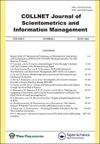Comparison of two science mapping tools based on software technical evaluation and bibliometric case studies
IF 0.8
Q2 INFORMATION SCIENCE & LIBRARY SCIENCE
COLLNET Journal of Scientometrics and Information Management
Pub Date : 2021-07-03
DOI:10.1080/09737766.2021.1960220
引用次数: 29
Abstract
Bibliometrics is used to apply statistical methods to books articles, and other publication. One research topic of bibliometrics is science mapping, which examines scientific objects to determine the cognitive structure, development, and acting persons. With CiteSpace and VOSviewer two of the most popular visualization tools are compared. The evaluation of the software solutions is carried out in two steps, the first step is a purely software technical evaluation based on the framework of Jadhav and Sonar (2011). In addition to functional similarities and differences between the tools, qualitative and technical aspects are examined. Both CiteSpace and VOSviewer, share a large number of bibliometric functionalities, which are each extended by additional functions. They use different algorithms for normalization, mapping and clustering. In the second part, on the basis of own case studies, in which selected bibliometric analyses (Co-Occurrence-, Co-Citation- and Co-Authorship- analyses) are carried out, the workflow of solving a given task with these tools is analyzed and the results are evaluated. Both tools support the steps of a science mapping process, which consists of the phases of data retrieval, preprocessing, network extraction, normalization, mapping, analysis, visualization and interpretation. As a result, can be noted that visualizations created with VOSviewer have better clarity and user-friendliness. CiteSpace, on the other hand, offers advantages in the evaluative analysis of network visualizations, e.g. by enabling analysis of the cluster nodes using a Cluster Explorer.基于软件技术评价和文献计量学案例的两种科学制图工具的比较
文献计量学用于将统计方法应用于书籍、文章和其他出版物。文献计量学的一个研究课题是科学测绘,它通过考察科学对象来确定其认知结构、发展和行为主体。本文将比较CiteSpace和VOSviewer这两种最流行的可视化工具。软件解决方案的评估分两步进行,第一步是基于Jadhav和Sonar(2011)框架的纯软件技术评估。除了工具之间的功能异同之外,还检查了质量和技术方面。CiteSpace和VOSviewer都共享了大量的文献计量功能,这些功能都通过附加功能进行了扩展。它们使用不同的归一化、映射和聚类算法。在第二部分,基于自己的案例研究,其中选择了文献计量分析(共现分析,共被引分析和合著分析),分析了使用这些工具解决给定任务的工作流程,并对结果进行了评估。这两个工具都支持科学制图过程的步骤,包括数据检索、预处理、网络提取、规范化、制图、分析、可视化和解释等阶段。因此,可以注意到,用VOSviewer创建的可视化具有更好的清晰度和用户友好性。另一方面,CiteSpace在网络可视化的评估分析方面提供了优势,例如,可以使用cluster Explorer对集群节点进行分析。
本文章由计算机程序翻译,如有差异,请以英文原文为准。
求助全文
约1分钟内获得全文
求助全文
来源期刊

COLLNET Journal of Scientometrics and Information Management
INFORMATION SCIENCE & LIBRARY SCIENCE-
自引率
0.00%
发文量
11
 求助内容:
求助内容: 应助结果提醒方式:
应助结果提醒方式:


